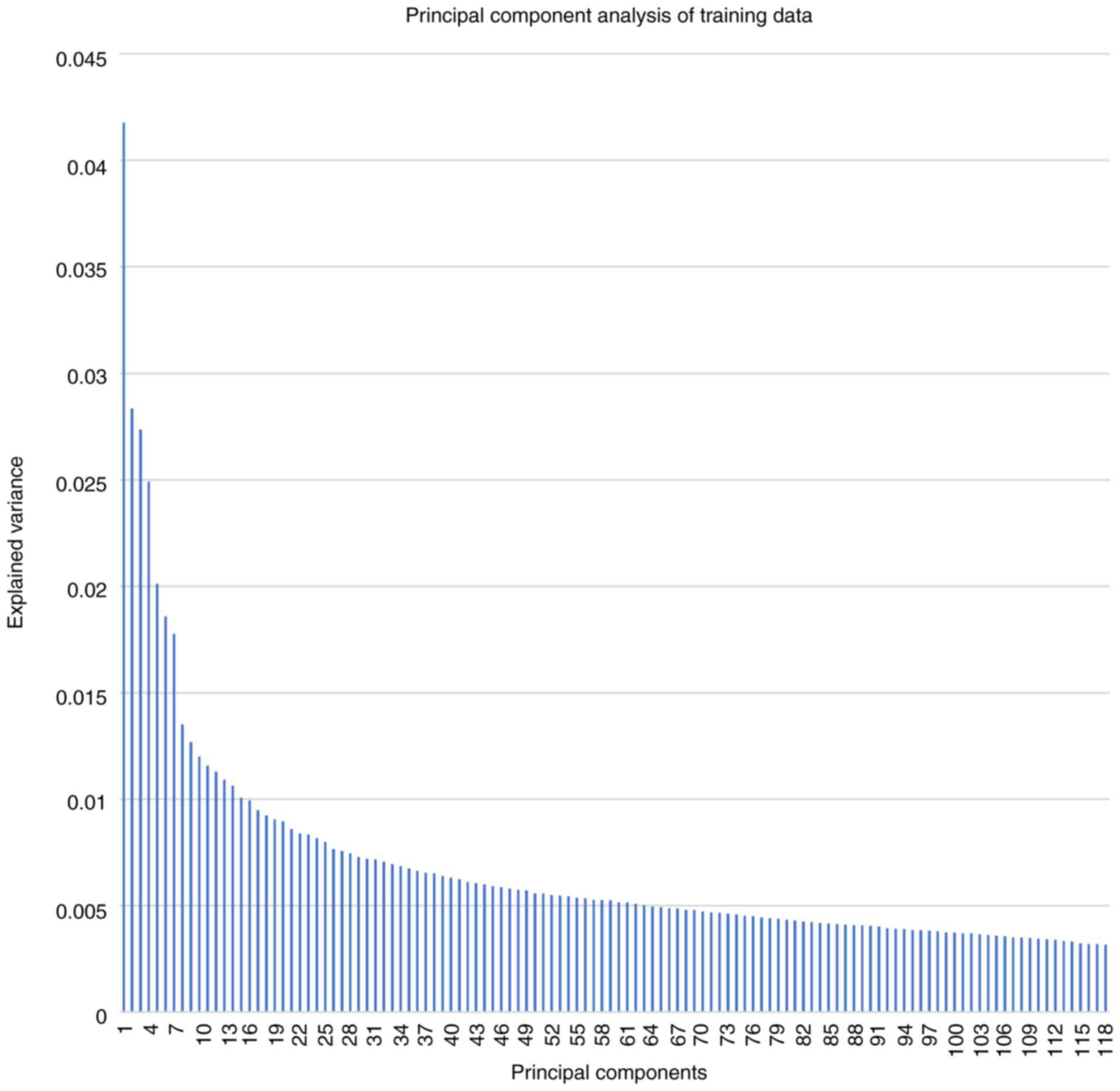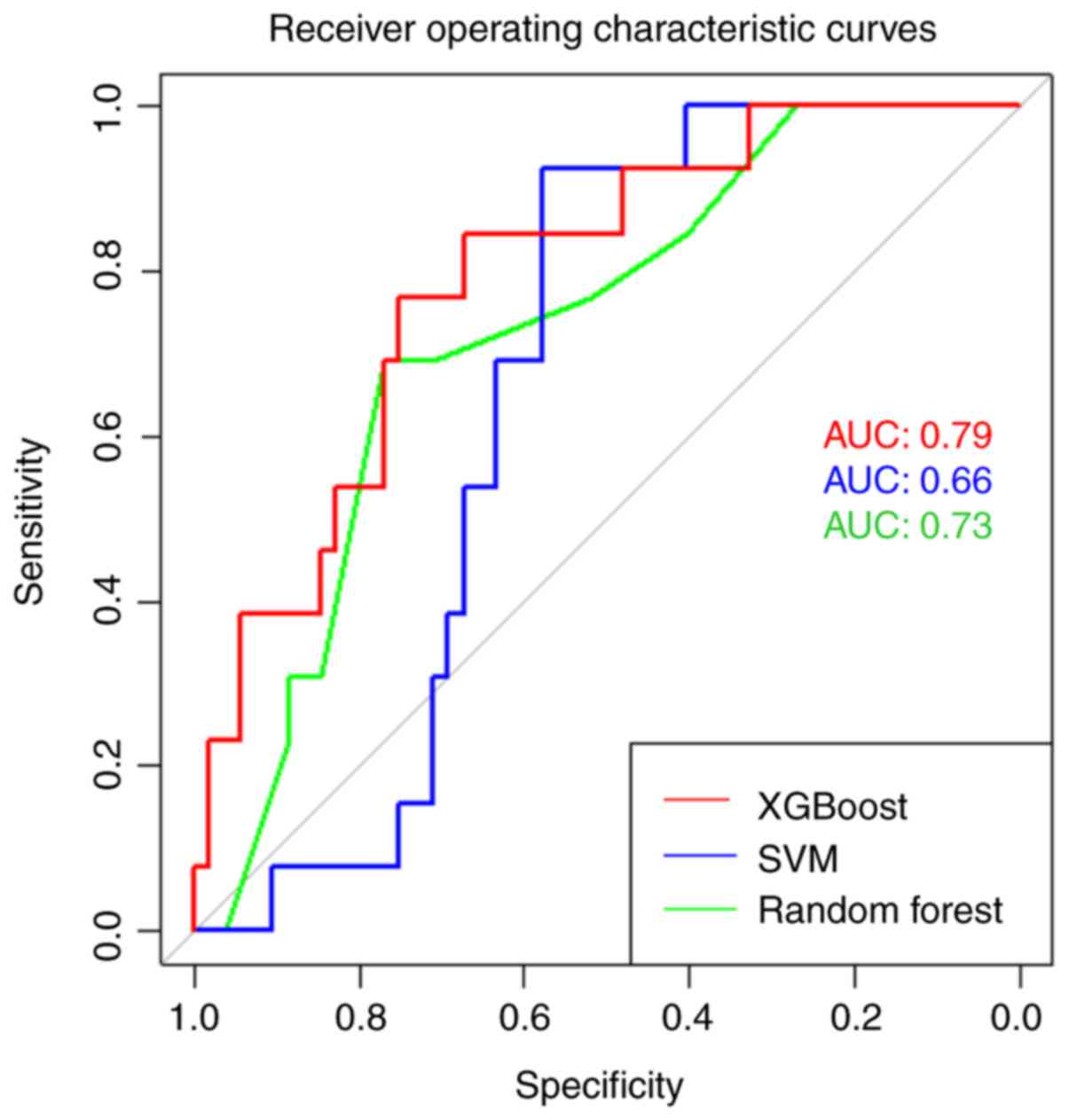|
1
|
Aaberg KM, Gunnes N, Bakken IJ, Lund
Søraas C, Berntsen A, Magnus P, Lossius MI, Stoltenberg C, Chin R
and Surén P: Incidence and prevalence of childhood epilepsy: A
nationwide cohort study. Pediatrics. 139(e20163908)2017.PubMed/NCBI View Article : Google Scholar
|
|
2
|
Kwan P and Brodie MJ: Early identification
of refractory epilepsy. N Engl J Med. 342:314–319. 2000.PubMed/NCBI View Article : Google Scholar
|
|
3
|
Smith SJ: EEG in the diagnosis,
classification, and management of patients with epilepsy. J Neurol
Neurosurg Psychiatry. 76 (Suppl 2):ii2–ii7. 2005.PubMed/NCBI View Article : Google Scholar
|
|
4
|
Mihara T, Inoue Y, Matsuda K, Tottori T,
Otsubo T, Watanabe Y, Hiyoshi T, Kubota Y, Yagi K and Seino M:
Recommendation of early surgery from the viewpoint of daily quality
of life. Epilepsia. 37 (Suppl 3):S33–S36. 1996.PubMed/NCBI View Article : Google Scholar
|
|
5
|
Westerveld M, Sass KJ, Chelune GJ, Hermann
BP, Barr WB, Loring DW, Strauss E, Trenerry MR, Perrine K and
Spencer DD: Temporal lobectomy in children: Cognitive outcome. J
Neurosurg. 92:24–30. 2000.PubMed/NCBI View Article : Google Scholar
|
|
6
|
Baulac M, de Boer H, Elger C, Glynn M,
Kälviäinen R, Little A, Mifsud J, Perucca E, Pitkänen A and Ryvlin
P: Epilepsy priorities in Europe: A report of the ILAE-IBE epilepsy
advocacy Europe task force. Epilepsia. 56:1687–1695.
2015.PubMed/NCBI View Article : Google Scholar
|
|
7
|
Berg AT, Baca CB, Loddenkemper T, Vickrey
BG and Dlugos D: Priorities in pediatric epilepsy research:
Improving children's futures today. Neurology. 81:1166–1175.
2013.PubMed/NCBI View Article : Google Scholar
|
|
8
|
Dlugos DJ: The early identification of
candidates for epilepsy surgery. Arch Neurol. 58:1543–1546.
2001.PubMed/NCBI View Article : Google Scholar
|
|
9
|
Gilliam F, Kuzniecky R, Meador K, Martin
R, Sawrie S, Viikinsalo M, Morawetz R and Faught E:
Patient-oriented outcome assessment after temporal lobectomy for
refractory epilepsy. Neurology. 53:687–694. 1999.PubMed/NCBI View Article : Google Scholar
|
|
10
|
Guerrini R: Epilepsy in children. Lancet.
367:499–524. 2006.PubMed/NCBI View Article : Google Scholar
|
|
11
|
Shah MN, Nguyen RD, Pao LP, Zhu L,
CreveCoeur TS, Mitra A and Smyth MD: Role of resting state MRI
temporal latency in refractory pediatric extratemporal epilepsy
lateralization. J Magn Reson Imaging. 49:1347–1355. 2019.PubMed/NCBI View Article : Google Scholar
|
|
12
|
Guidelines for neuroimaging evaluation of
patients with uncontrolled epilepsy considered for surgery.
Commission on neuroimaging of the international league against
epilepsy. Epilepsia. 39:1375–1376. 1998.PubMed/NCBI View Article : Google Scholar
|
|
13
|
Recommendations for neuroimaging of
patients with epilepsy. Commission on neuroimaging of the
international league against epilepsy. Epilepsia. 38:1255–1256.
1997.PubMed/NCBI View Article : Google Scholar
|
|
14
|
Biswal B, Yetkin FZ, Haughton VM and Hyde
JS: Functional connectivity in the motor cortex of resting human
brain using echo-planar MRI. Magn Reson Med. 34:537–541.
1995.PubMed/NCBI View Article : Google Scholar
|
|
15
|
Mitra A, Snyder AZ, Blazey T and Raichle
ME: Lag threads organize the brain's intrinsic activity. Proc Natl
Acad Sci USA. 112:E2235–E2244. 2015.PubMed/NCBI View Article : Google Scholar
|
|
16
|
Mitra A, Snyder AZ, Hacker CD and Raichle
ME: Lag structure in resting-state fMRI. J Neurophysiol.
111:2374–2391. 2014.PubMed/NCBI View Article : Google Scholar
|
|
17
|
Jirsa VK, Proix T, Perdikis D, Woodman MM,
Wang H, Gonzalez-Martinez J, Bernard C, Bénar C, Guye M, Chauvel P
and Bartolomei F: The virtual epileptic patient: Individualized
whole-brain models of epilepsy spread. Neuroimage. 145:377–388.
2017.PubMed/NCBI View Article : Google Scholar
|
|
18
|
Pizoli CE, Shah MN, Snyder AZ, Shimony JS,
Limbrick DD, Raichle ME, Schlaggar BL and Smyth MD: Resting-state
activity in development and maintenance of normal brain function.
Proc Natl Acad Sci USA. 108:11638–11643. 2011.PubMed/NCBI View Article : Google Scholar
|
|
19
|
Proix T, Bartolomei F, Guye M and Jirsa
VK: Individual brain structure and modelling predict seizure
propagation. Brain. 140:641–654. 2017.PubMed/NCBI View Article : Google Scholar
|
|
20
|
Beckmann CF, DeLuca M, Devlin JT and Smith
SM: Investigations into resting-state connectivity using
independent component analysis. Philos Trans R Soc Lond B Biol Sci.
360:1001–1013. 2005.PubMed/NCBI View Article : Google Scholar
|
|
21
|
Bharath RD, Panda R, Raj J, Bhardwaj S,
Sinha S, Chaitanya G, Raghavendra K, Mundlamuri RC, Arimappamagan
A, Rao MB, et al: Machine learning identifies ‘rsfMRI epilepsy
networks’ in temporal lobe epilepsy. Eur Radiol. 29:3496–3505.
2019.PubMed/NCBI View Article : Google Scholar
|
|
22
|
Boerwinkle VL, Mirea L, Gaillard WD,
Sussman BL, Larocque D, Bonnell A, Ronecker JS, Troester MM,
Kerrigan JF, Foldes ST, et al: Resting-state functional MRI
connectivity impact on epilepsy surgery plan and surgical
candidacy: Prospective clinical work. J Neurosurg Pediatr. 1–8.
2020.PubMed/NCBI View Article : Google Scholar : (Online ahead of
print).
|
|
23
|
Boerwinkle VL, Mohanty D, Foldes ST,
Guffey D, Minard CG, Vedantam A, Raskin JS, Lam S, Bond M, Mirea L,
et al: Correlating resting-state functional magnetic resonance
imaging connectivity by independent component analysis-based
epileptogenic zones with intracranial electroencephalogram
localized seizure onset zones and surgical outcomes in prospective
pediatric intractable epilepsy study. Brain Connect. 7:424–442.
2017.PubMed/NCBI View Article : Google Scholar
|
|
24
|
Shah MN, Mitra A, Goyal MS, Snyder AZ,
Zhang J, Shimony JS, Limbrick DD, Raichle ME and Smyth MD: Resting
state signal latency predicts laterality in pediatric medically
refractory temporal lobe epilepsy. Childs Nerv Syst. 34:901–910.
2018.PubMed/NCBI View Article : Google Scholar
|
|
25
|
Darcy AM, Louie AK and Roberts LW: Machine
learning and the profession of medicine. JAMA. 315:551–552.
2016.PubMed/NCBI View Article : Google Scholar
|
|
26
|
Deo RC: Machine learning in medicine.
Circulation. 132:1920–1930. 2015.PubMed/NCBI View Article : Google Scholar
|
|
27
|
Rajkomar A, Dean J and Kohane I: Machine
learning in medicine. N Engl J Med. 380:1347–1358. 2019.PubMed/NCBI View Article : Google Scholar
|
|
28
|
Jordan MI and Mitchell TM: Machine
learning: Trends, perspectives, and prospects. Science.
349:255–260. 2015.PubMed/NCBI View Article : Google Scholar
|
|
29
|
Cortes C and Vapnik V: Support-vector
networks. Mach Learn. 20:273–297. 1995.
|
|
30
|
Chen T and Guestrin C: XGBoost: A scalable
tree boosting system. In Proceedings of the 22nd acm sigkdd
international conference on knowledge discovery and data mining,
pp785-794, 2016.
|
|
31
|
Liaw A and Wiener M: Classification and
regression by randomForest. R News. 2:18–22. 2002.
|
|
32
|
Fern A and Givan R: Online ensemble
learning: An empirical study. Mach Learn. 53:71–109. 2003.
|
|
33
|
Mennes M, Biswal BB, Castellanos FX and
Milham MP: Making data sharing work: The FCP/INDI experience.
Neuroimage. 82:683–691. 2013.PubMed/NCBI View Article : Google Scholar
|
|
34
|
Bellec P, Chu C, Chouinard-Decorte F,
Benhajali Y, Margulies DS and Craddock RC: The neuro bureau
ADHD-200 preprocessed repository. Neuroimage. 144:275–286.
2017.PubMed/NCBI View Article : Google Scholar
|
|
35
|
Brier MR, Thomas JB, Snyder AZ, Benzinger
TL, Zhang D, Raichle ME, Holtzman DM, Morris JC and Ances BM: Loss
of intranetwork and internetwork resting state functional
connections with Alzheimer's disease progression. J Neurosci.
32:8890–8899. 2012.PubMed/NCBI View Article : Google Scholar
|
|
36
|
Kowerko D: https://www.mathworks.com/matlabcentral/fileexchange/49823-calc_overlap_twonormal(s1,s2,mu1,mu2,xstart,xend,xinterval).
MATLAB Central File Exchange. Retrieved July 19, 2021.
|
|
37
|
Jenkinson M, Beckmann CF, Behrens TE,
Woolrich MW and Smith SM: FSL. Neuroimage. 62:782–790.
2012.PubMed/NCBI View Article : Google Scholar
|
|
38
|
Verleysen M and François D: The Curse of
Dimensionality in Data Mining and Time Series Prediction. Vol 3521.
IWANN 2005: Computational Intelligence and Bioinspired Systems,
pp758-770, 2005.
|
|
39
|
Meyer D, Dimitriadou E, Hornik K,
Weingessel A and Leisch F: e1071: Misc functions of the department
of statistics, probability theory group (Formerly: E1071), TU Wien,
2017.
|
|
40
|
R Core Team: R: A Language and Environment
for Statistical Computing. R Foundation for Statistical Computing,
Vienna, Austria, 2019. Available from: http://www.r-project.org/index.html.
|
|
41
|
RStudio Team: RStudio: Integrated
Development for R. RStudio, Inc., Boston MA (Computer Software
v0.98.1074), 2015.
|
|
42
|
Sasaki Y: The truth of the F-measure.
Teach Tutor Mater, 2007.
|
|
43
|
Baca CB, Vickrey BG, Vassar S, Hauptman
JS, Dadour A, Oh T, Salamon N, Vinters HV, Sankar R and Mathern GW:
Time to pediatric epilepsy surgery is related to disease severity
and nonclinical factors. Neurology. 80:1231–1239. 2013.PubMed/NCBI View Article : Google Scholar
|
|
44
|
Loddenkemper T, Holland KD, Stanford LD,
Kotagal P, Bingaman W and Wyllie E: Developmental outcome after
epilepsy surgery in infancy. Pediatrics. 119:930–935.
2007.PubMed/NCBI View Article : Google Scholar
|
|
45
|
Berg AT, Vickrey BG, Testa FM, Levy SR,
Shinnar S, DiMario F and Smith S: How long does it take for
epilepsy to become intractable? A prospective investigation. Ann
Neurol. 60:73–79. 2006.PubMed/NCBI View Article : Google Scholar
|
|
46
|
Trevathan E and Gilliam F: Lost years:
Delayed referral for surgically treatable epilepsy. Neurology.
61:432–433. 2003.PubMed/NCBI View Article : Google Scholar
|
|
47
|
Elger CE, Helmstaedter C and Kurthen M:
Chronic epilepsy and cognition. Lancet Neurol. 3:663–672.
2004.PubMed/NCBI View Article : Google Scholar
|
|
48
|
Sperling MR: Sudden unexplained death in
epilepsy. Epilepsy Curr. 1:21–23. 2001.PubMed/NCBI View Article : Google Scholar
|
|
49
|
Nguyen RD, Kennady EH, Smyth MD, Zhu L,
Pao LP, Swisher SK, Rosas A, Mitra A, Patel RP, Lankford J, et al:
Convolutional neural networks for pediatric refractory epilepsy
classification using resting-state functional magnetic resonance
imaging. World Neurosurg. 149:e1112–e1122. 2021.PubMed/NCBI View Article : Google Scholar
|
|
50
|
Hastie T, Tibshirani R and Friedman J: The
Elements of Statistical Learning: Data Mining, Inference and
Prediction. Springer, New York, NY, 2016.
|
|
51
|
Di Martino A, O'Connor D, Chen B, Alaerts
K, Anderson JS, Assaf M, Balsters JH, Baxter L, Beggiato A,
Bernaerts S, et al: Enhancing studies of the connectome in autism
using the autism brain imaging data exchange II. Sci Data.
4(170010)2017.PubMed/NCBI View Article : Google Scholar
|
|
52
|
Di Martino A, Yan CG, Li Q, Denio E,
Castellanos FX, Alaerts K, Anderson JS, Assaf M, Bookheimer SY,
Dapretto M, et al: The autism brain imaging data exchange: Towards
a large-scale evaluation of the intrinsic brain architecture in
autism. Mol Psychiatry. 19:659–667. 2014.PubMed/NCBI View Article : Google Scholar
|
|
53
|
Schölkopf B and Smola AJ: Learning with
Kernels: Support Vector Machines, Regularization, Optimization, and
Beyond. Adaptive Computation and Machine Learning Series, 2018.
|
















